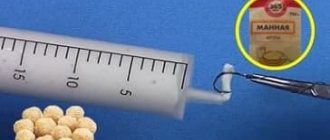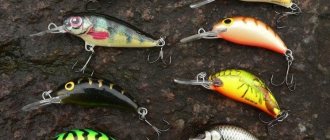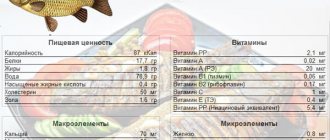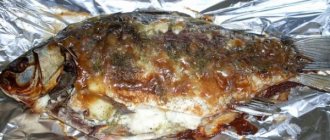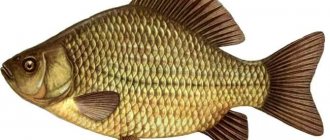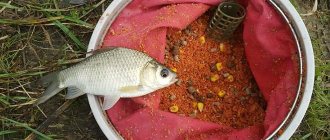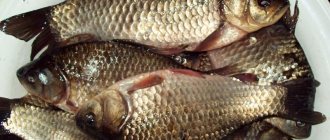Hot pea crumpet
Take half a glass of unpeeled peas, pour it into an iron bowl and pour in a little less than a glass of warm water, after which the peas should sit for a while and absorb the liquid. After the peas have swollen and partially absorbed the water, add warm water to such a level that it covers the peas, and then begin to cook over low heat (immediately after boiling). The pulp should be cooked for two hours, constantly stirring the contents, while trying to avoid burning, since fish does not like the smell of burning.
Bring the resulting mixture to a mushy mass, then add a tablespoon of sugar and two pinches of vanillin. While stirring the resulting mixture, add semolina (until the paste thickens). As soon as the resulting mixture reaches the state of kneaded dough, remove it from the stove and grind it in a meat grinder to crush large lumps.
After this, the hot-cooked pea crumpet is ready. It is convenient to roll it into balls, the bait stays well on the hook, and the aroma attracts hungry fish.
Complementary foods can be stored in the freezer.
Donuts for carp.
I bring to your attention another recipe based on what is loved by carp, crucian carp and many other fish - peas.
The beginning, as with most pea baits, is the same. Take half a glass of peas, not shelled ones, pour them into a prepared container and fill them with warm water, all this remains until the peas absorb the water and swell accordingly. After the peas swell and absorb some of the water, it will need to be added in such an amount that all the peas are covered with water. We put this whole preparation on the stove, bring it to a boil, and cook over low heat, which we switch to immediately after boiling. During the cooking process, which lasts about 2 hours, you need to stir the pulp all the time to avoid burning, since this smell will only scare away the fish. As a result, after cooking we will get a porridge-like mass; add a tablespoon of sugar and a little vanillin to the hot pulp. While stirring the porridge, add semolina, add it until the porridge thickens, until the dough stops sticking to your hands. The resulting mass, the so-called “crumpet,” can be passed through a meat grinder, which will reduce the number of lumps in it. As a result, we get bait that rolls well into balls, holds securely on the hook and smells aromatic, attracting fish. You can store the cooked crumpet in the freezer and use it several times, after defrosting it.
The above recipe for preparing bait for carp , crucian carp and other cyprinids can be called pea crumpet, so to speak “hot” preparation. The next recipe will be “cold” cooked. To prepare such bait, we need pea flour, namely three tablespoons, mix it with a chicken egg (fresh, not boiled). Add flour to the resulting mass, kneading the whole thing into a dough until it stops sticking. If you can’t buy pea flour, there is a way to prepare it at home, even if it’s not the easiest. It is best to grind pea grains in a grain mill or coffee grinder. The resulting cereal can be crushed and sifted through a fine sieve. Sometimes there is a desire to go fishing in another country, to try local baits. To realize such ideas, you need, of course, to fly by plane, fortunately, the sale of air tickets online is so developed that there are simply no problems with purchasing tickets. If only you had money and you could fly wherever your heart desires, you want to fly, relax, you want to fly to fish. I bought a ticket online and went ahead, but these are all dreams, the reality is a little different.
The advantage of such bait was already described during preparation, it is not soggy in the water, it is easy to hook, the aroma attracts fish, well, at least large carp or crucian carp. Among the disadvantages, one can note the difficulty in preparation, as with most pea attachments.
Share with friends:
Publication date: 09/10/2012
Add a comment Cancel reply
Cold cooked pea crumpet
For cold-cooked pea crumpet we need pea flour, raw chicken egg and wheat flour.
Pour a chicken egg into three tablespoons of pea flour and carefully mix the resulting mixture until smooth. Add wheat flour to the resulting mixture and knead the complementary foods until it forms a dough that does not stick to your hands. The cold brew mixture is ready.
If you don’t have pea flour, and the nearest stores have a small selection, then you can make the flour with your own hands. Pea grains can be ground in a coffee grinder or grain mill, after which the resulting cereal is crushed with a mortar or blender and passed through a sieve.
Fishing on the Don
Tackle, equipment and equipment. Testing something new, describing what has been tried.
Recipes for my most catchy crumpets (for crucian carp, carp, bream, roach, vimba, podusta, etc.):
1. “Hot” prepared pea crumpet (troublesome and almost never used, home-made): Pour half a glass of unshelled peas into a saucepan and pour warm water so that it absorbs some of the water and swells. As soon as the water is absorbed, you need to add just enough water to cover the peas. Then put it on the fire, let it boil and immediately reduce the heat to low - cook for two hours, stirring, so as not to burn (the smell of burnt will definitely scare away the fish). At the end of cooking, the peas look like a monotonous, squishing and steaming mass. While it is hot, you need to add a tablespoon of sugar and some vanillin crystals. While stirring, add semolina to it until it turns into a lump that does not stick to your hands. You can pass the crumpet through a meat grinder so that there are no lumps. If everything is done correctly, the crumpet will not dry out, will roll into balls well, stay firmly on the hook and will smell delicious. If you fish with one float rod, then as a rule there is less crumpet for the day of fishing than prepared. Therefore, it is better to divide the cooked and cooled donut into portions, pack them in different plastic bags and put them in the freezer of the refrigerator. It is recommended to do the same with crumpets obtained according to the recipes described below. It is enough to place the frozen crumpet in the cooling chamber of the refrigerator the evening before morning fishing and it will be ready for morning fishing. And for fishing, which takes several hours to get to, you can take frozen crumpet; this way it will better retain its properties. When stored for a long time in a plastic bag at positive ambient temperatures, donuts tend to become moldy, which is not to the fish’s taste at all! 2. “Cold” pea crumpet: Mix three tablespoons of pea flour with the contents of a fresh raw chicken egg. Add wheat flour to the resulting sticky mass, kneading it into the dough until you get a dough ball, the balls of which will not stick to your hands and at the same time will stick well to the hook. The difficulty in making crumpet is where to get the pea flour. The mixer does not pick up peas because they are hard. A coffee grinder or grain mill helps. In this case, the peas are ground at best into cereal. And, in order to extract flour from cereals, it is enough to sift the cereals on a fine-mesh sieve. It is better to prepare pea flour for future use. I always have a jar of this kind of flour lying around in my car, from which I can quickly mix mash with river water if necessary. 3. Cold-cooked cake donut: The donut is made in the same way as in the previous recipe. Only instead of pea flour we use flour, which is easier to buy ready-made at a fishing store.
Bait recipe for moderate currents (works on all carp): In the evening we prepare two strong new plastic bags. We insert one package into another. In such a two-layer “thermos” we pour 1/3 of a kilogram bag of “Hercules” oatmeal and a two hundred gram glass of “faceted” makukha. Twist the bag and mix the mixture dry. Then carefully pour 0.4-0.6 liters of boiling water (steep boiling water) into the bag with the mixture. Just in case, it is better to perform this procedure over a sink and remember that hot steam can scald not only your hands, but also your stomach, and even your penis, if your stomach does not protect it from above. Then, leaving air in the bag of porridge, tie a loop knot around the neck (of the bag) and, using a towel, knead the porridge in the bag. At night, wrap the bag in the same towel and leave it until the morning. In the morning, “on a cold day,” you can knead the porridge, and when fishing, make a hole in a double bag and pour out the required amount of viscous porridge to make balls. The balls of such porridge should turn out viscous, creating a turbidity that attracts fish immediately after sinking to the bottom. With some training, such preparation of bait does not cause any trouble. And most importantly, you don’t need to wash or throw away the pan after porridge!
How and what kind of fish to catch with these beans
If you come to the reservoir for the first time, then you first need to find out a few details:
- who lives in it, what kind of fish,
- what are their preferences,
- at what time of year and day (also weather conditions) the intensity of the bite increases and decreases,
- features of the bottom surface (choice of gear),
- feeding areas of target aquatic inhabitants,
- ratio of the number of predators and herbivores,
- How local fish feel about peas and dishes made from them.
There are three ways to find out the relevant criteria. The first method is the most difficult - try it, select it yourself. The second method is available in relation to large bodies of water - read articles and look at reviews on the Internet. Almost no one writes about small wild waters or makes videos. The third method is much simpler - ask local old fishermen who have been coming here for many years.
Attention! If a reservoir is inhabited by a very large number of predatory inhabitants, then no bait for catching peaceful fish will help you. The predator will instantly disperse it. It is also inappropriate to use peas in waters where they are “alien” to fish at all.
Cupid White
This species is special not only in its way of life, but also in the fishing process itself. He does not bite on pea porridge, boiled and steamed beans (unless he is very hungry). Grass carp are caught on the fresh leaves of this plant or young pods! It is recommended to add filamentous algae and the same ingredients to the bait. The tackle required is a float, plug or match.
IMPORTANT! White Cupid is a strong fish. One of the largest species of the Cyprinidae family. You need to be as careful as possible when fishing it.
crucian carp
Unfortunately, there are no requirements regarding crucian carp. Why in a negative sense: although this fish is distinguished by its simple diet (it is practically omnivorous), but on a particular body of water under certain conditions the fisherman has to spend a long time selecting bait and attachment. Crucian peas can be consumed in different forms, except for raw fruits. He can cook porridge, steam or soak beans, and make crumpet. There are no requirements for fishing gear. This includes float rods, donks (“rubber bands”), feeders, and so on.
Carp
This fish is generally called by the people “underwater pig”. Carp can attack and eat whatever they like. He is also partial to peas. Carps love steamed peas, canned, soaked, boiled, and sometimes raw beans. A prerequisite is the presence of sugar. These fish love sweets. Try to add cake to complementary foods. Large carp try to stay on the bottom during the daytime. Early in the morning or evening they can be found in the reeds near the shore.
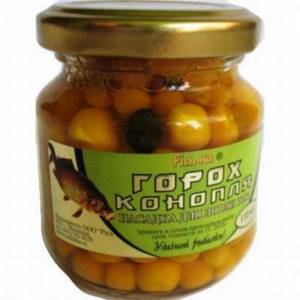
In fishing stores you can find soaked peas flavored with hemp oil. They are aimed at catching carp and crucian carp.
Tench
Traper baits
Tenches are one of the most valuable fish species. They are distinguished by caution, laziness and a keen choice of food - a capricious fish. The fisherman should pay close attention to casting gear and feeding. The tench is afraid of noise and, when frightened, lies down on the surface of the bottom. Lures and bait made from peas attract him very well. Tench have a lot of fat in their body, and such fish need high-calorie food. This inhabitant consumes fruits in almost any form, except for fresh beans and pods. Nozzles - soaked, boiled, steamed or canned peas (less often). Food - porridge, mastyrki, cakes made from pea flour and dry mixtures with crushed beans. Tench usually stands in grassy areas of the reservoir: thick algae, thickets of cattails, reeds or swimsuits.
Ide
For ide, experienced fishermen soak and then boil the peas so that they are strong. Small and fallen beans are added to the bait, and the rest go to the hooks. Cake is used as the best flavoring agent, but you can stop there. We catch ides using peas in rivers from a boat, using a float rod as the tackle. This fish willingly stands in snaggy places and where there are flooded bushes.
Carp
Large carp, like bream, spend most of their time at the bottom. Their favorite treat is pea boilies with sugar. This dish has a rich taste, but keep in mind that you will have to use large baits if you are going for large inhabitants. When the bait is small, it can be attacked by small fish. She avoids everything that is larger than the size of her mouth. We catch carp in late spring, summer or early autumn. At other times of the year, these fish completely lose activity.

The main advantage of boilies is the high distribution of odor in water and slow solubility even during currents.
Bream
Bream can easily be attracted by the same boilies and pea cakes. Extracting flour requires a lot of time and labor. First, the beans have to be crushed, ground, and then sifted several times. Large bream live on the bottom in schools. Pea dough for fishing is made simpler: add a chicken egg to the flour and mix with semolina. Feeders, hooks, “Eggs” (from a boat) and other donks are suitable as gear. Fishing for bream on peas, in terms of the time of year, is similar to carp.
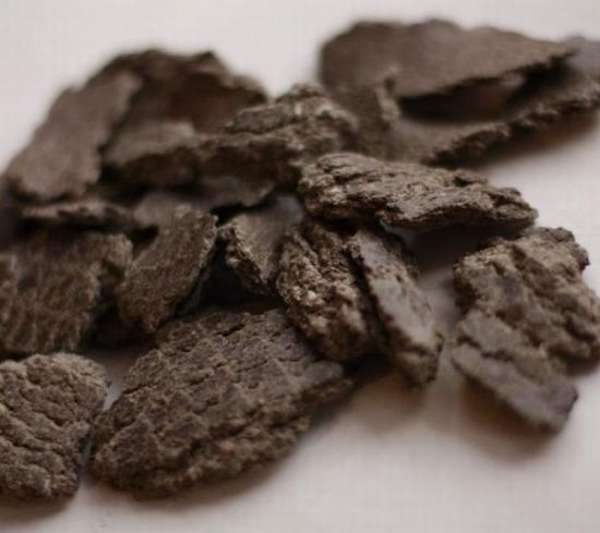
Always take the pulp with you separately. With a low-intensity bite, it can become an indispensable assistant. Add it to your bait.
Roach
Roaches like porridge made from peas and millet. As for the attachments - soaked or boiled (steamed) peas with anise or hemp aroma. There is one important requirement for complementary feeding: the mixture must match the color of the bottom so that the roach is not noticed by predators (this fish tries to be camouflaged). The problem is solved by adding dark soil (if the bottom is muddy) collected from the same reservoir.
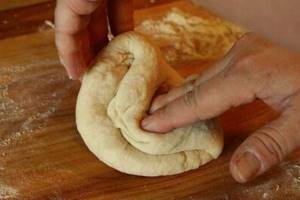
Pea dough can be used both as a bait and as a sinking bait.
Representatives of carp fish need high-calorie food, but the fisherman should know that overfeeding the fish is strictly prohibited. A small handful of bait every 20 minutes will be enough. Most fishing gear is focused on bottom fishing, which means that the food must be appropriate - sinking. We also advise anglers to remember that burnt pea dishes are unsuitable either as bait or bait. This smell repels aquatic life.
(
1 ratings, average: 3.00 out of 5)
Peas for fishing. A simple recipe for making a thick bait
After some fishermen prepared hominy according to the recipe from our website, many questions arose about how to cook peas. Simply boiled pea porridge is not very suitable for attachment, and you don’t always want to “tinker” with pea porridge (a mixture based on peas). So why not try taking pea flour, mixing it with wheat flour and boiling this mixture in bags? But not everything is as simple as it turned out.

I had to choose my own proportion and cooking time. Over the past season, this mixture was tested on rivers more than once. As expected, the bream appreciated it well. There are reservoirs where peas are almost the best bait for white fish, and for such conditions we offer two cooking options.
First, we present our video “How to cook peas for fishing?”
Now a little theory.
Option-1 In our opinion, the most accessible and simplest method. First you need to cook regular pea porridge. For this purpose, take yellow peas, pour in twice as much water as the cereal, and cook for about an hour until all the grains are boiled. After cooking, drain off excess water (if any). So, we need:
Mix porridge and wheat flour in a ratio of 2 to 1 (by weight). The finished mixture in this proportion will be of medium density. If you need to increase the density, then make a ratio of 1 to 1. Add water, mix, achieving the consistency of thick sour cream. You can also add your favorite aromatics at this stage.
Pour the mixture into a bag. It is better to use two bags to prevent leaks during cooking.
Option-2 We will need:
Mix pea and wheat flour 1k1. With a lower concentration of wheat flour, the mixture will crumble; with a higher concentration, we obtain the necessary density and stickiness, but lose the smell of peas (the result is a regular “dough” with a slight pea aroma).
We get such a nozzle. It is darker (understandable, because not only yellow grains will be used for flour) and less sticky, more suitable for smooth casting.


Share your ways of cooking peas in the comments. Try ours, write your comments and suggestions. For example, as an option, you can also mix the crumb of white bread and ready-made pea porridge in a blender, adding water until the required consistency is obtained. So there are many recipes, the main thing is to choose one that is easy and catchy. Health and Joy to everyone!
Recipes for the most catchy baits for catching crucian carp
We bring to your attention several of the most popular recipes for preparing baits at home, intended for catching crucian carp.
Cake boilies
- 300 g of ground seed cake;
- 200 g ground soybeans (or soy flour);
- 200 g semolina;
- 200 g milk powder.
Pea nozzle
Place a teaspoon of soda in a liter thermos and add a little linseed or hemp oil. Pour one glass of peas and pour boiling water over it. Then you need to close the thermos and leave for 6-8 hours. The same method can be used to prepare millet, grain, pearl barley, etc.
Semolina boilies
- 400 g semolina;
- 200 g soybeans (or soy flour);
- 200 g corn flour;
- 150-200 g of powdered milk;
- 50 g powdered sugar.
Rice boilies
- 100 g rice flour;
- 100 g wheat flour;
- 100 g corn flour;
- 100 g ground poultry food;
- 100 g milk powder.
Protein boilies
- 400 g corn flour;
- 200 g semolina;
- 200 g soy flour;
- 100 g cake, hemp or roasted seeds;
- 100 g of milk protein (can be purchased at any sports nutrition store);
- 50 g salt as a preservative.
Semolina
Cook semolina porridge over low heat, stirring constantly, until a dense viscous mass is obtained. Then they wait until it cools down and add a couple of pieces of ground cookies to it. Then mix everything thoroughly again. And finally, the finished semolina porridge needs to be rolled in attractants. And already on the pond it needs to be cut into small cubes and put on the hook so that the tip is completely covered.
Barley porridge
To prepare such an attachment, add a glass of pearl barley to a pan of water and boil for about 15 minutes. Then the pearl barley is doused with cold water several times to wash off the sticky fat from it. The result is small grains that are hard inside. Add a little vegetable oil to the cooled pearl barley so that it does not stick together during storage and the grains are easily separated from each other.
Depending on the hook number, one or two or three grains are placed on it.
Pearl barley porridge with breadcrumbs
The barley is cooked over low heat for approximately 15-20 minutes. Periodically you need to stir it and watch so that it does not burn. To check readiness, you need to catch a few grains and crush them. If there is no dry, uncooked mass inside, the pearl barley is ready.
Then you need to rinse and dry the cereal, sprinkle it with regular breadcrumbs and mix everything thoroughly. Crumb crumbs will stick to the pearl barley and form shaggy grains. In the water, small pieces of crackers begin to fall off from the bait prepared in this way, and this very much attracts the fish and activates its biting.
Cereal grains
There are two options for using cereal grains. First: young grains were collected during the period of milky ripeness of the ear. Fresh grains are simply placed on a hook, 1-3 pieces at a time, and caught.
Second: when we are dealing with old grains. In this case, they must first be washed and then soaked for 10-12 hours in water at room temperature. Please note that longer soaking may cause the grains to sour. The finished, swollen grain should be placed in a pot or pan, lightly filled with water and steamed a little in the oven or simmered over low heat. The grains should become soft, but without the shell bursting. The finished grains are placed on a thin hook, 1-3 pieces at a time, slightly extending the tip of the hook tip outwards.
We hope our recipes will help you in preparing baits for catching crucian carp. Good luck!
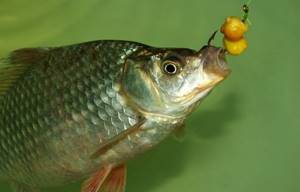
Bait is extremely important!
In fact, complementary feeding plays one of the most important roles when fishing. After all, with its help, the fisherman creates the best conditions for biting and catching exactly the type of fish he came for. Good complementary feeding can increase the bite several times; in addition, the fish become less cautious, since by feeding the fishing area, the angler accustoms the fish to his bait.
Avid carp fishermen know very well that there is no universal remedy for uninterrupted carp bites, because... these fish are quite picky and often change their gastronomic preferences. In such a situation, only the fisherman’s many years of experience and his intuition help out, with the help of which the fisherman is able to select effectively working baits.
Before starting to prepare the bait mixture, the fisherman must carefully and thoughtfully study the places of future fishing. For successful fishing, it is important to know what factors can affect the ingredients of complementary food, types and its density.
These are the factors:
- water temperature;
- current strength;
- water clarity;
- underwater thickets in the fishing area.
If you plan to catch carp at shallow depths and insignificant currents, then you need to add additional ballast to the complementary food - soil, ideally dry. When preparing complementary foods, it is also important not to overdo it with water. Therefore, you need to add water in small portions, mixing thoroughly each time. The bait for such fishing areas should be a little rough.
If there is no current at all in the fishing area, then complementary feeding should be even denser.
If fishing is to be done in a stagnant body of water or in a quiet backwater, then coastal sand should be added to the mixture in a ratio of 5 to 1 of the total volume.
In accordance with the seasons of the year, flavorings are added to complementary food for carp fishing:
- In the warm season - summer and spring, carp like the aromas of cinnamon and anise oil; you can also add berry and fruit smells to complementary foods. Fish responds well to apple, banana and pear flavorings;
- In winter, carp react more readily to corn with meat aromas.
In summer and winter, you should not overdo it with complementary foods, and in the fall or spring (since carp have a period of gluttony), you can throw in more complementary foods. In any case, the fisherman’s task is only to attract fish, and not to saturate it.
Well, now the recipes for especially catchy crumpets for catching carp and fish of the carp family.
Hot pea crumpet
Half a glass of unpeeled peas should be poured into an iron bowl and filled with a glass of warm water. The peas need to be left for a while so that they have time to absorb water. When the peas swell, partially absorbing water, you need to add enough water so that all the peas are in the water. Let's cook it. As soon as it boils, reduce the heat to minimum. The peas need to be cooked for two hours, stirring regularly, and making sure that they do not burn, otherwise everything will have to be redone. Fish react extremely negatively to the smell of burnt food.
The mixture should have a mushy consistency. At the end of cooking, add a tablespoon of sugar and a couple of pinches of vanillin to the peas. If the porridge is not thick enough, you can add semolina to it. As soon as the mixture has acquired the consistency of kneaded dough, the hot-cooked pea crumpet is ready.
It rolls into balls without any problems, stays on the hook perfectly, and its smell attracts hungry carp.
This crumpet is stored in the freezer, after melting, it retains its properties.
Bait is extremely important!
In fact, complementary feeding plays one of the most important roles when fishing. After all, with its help, the fisherman creates the best conditions for biting and catching exactly the type of fish he came for. Good complementary feeding can increase the bite several times; in addition, the fish become less cautious, since by feeding the fishing area, the angler accustoms the fish to his bait.
Avid carp fishermen know very well that there is no universal remedy for uninterrupted carp bites, because... these fish are quite picky and often change their gastronomic preferences. In such a situation, only the fisherman’s many years of experience and his intuition help out, with the help of which the fisherman is able to select effectively working baits.
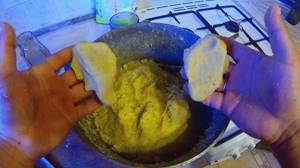
When preparing complementary foods, the fisherman must take into account the characteristics of the reservoir, weather and other factors.
Before starting to prepare the bait mixture, the fisherman must carefully and thoughtfully study the places of future fishing. For successful fishing, it is important to know what factors can affect the ingredients of complementary food, types and its density.
These are the factors:
- water temperature;
- current strength;
- water clarity;
- underwater thickets in the fishing area.
If you plan to catch carp at shallow depths and insignificant currents, then you need to add additional ballast to the complementary food - soil, ideally dry. When preparing complementary foods, it is also important not to overdo it with water. Therefore, you need to add water in small portions, mixing thoroughly each time. The bait for such fishing areas should be a little rough.
If there is no current at all in the fishing area, then complementary feeding should be even denser.
If fishing is to be done in a stagnant body of water or in a quiet backwater, then coastal sand should be added to the mixture in a ratio of 5 to 1 of the total volume.
In accordance with the seasons of the year, flavorings are added to complementary food for carp fishing:
- In the warm season - summer and spring, carp like the aromas of cinnamon and anise oil; you can also add berry and fruit smells to complementary foods. Fish responds well to apple, banana and pear flavorings;
- In winter, carp react more readily to corn with meat aromas.
In summer and winter, you should not overdo it with complementary foods, and in the fall or spring (since carp have a period of gluttony), you can throw in more complementary foods. In any case, the fisherman’s task is only to attract fish, and not to saturate it.
Well, now the recipes for especially catchy crumpets for catching carp and fish of the carp family.
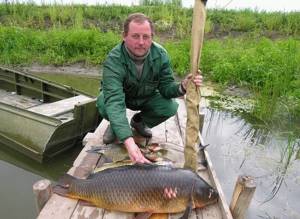
Pea crumpets work great when fishing for carp
Catching recipes for “donuts” for carp fishing | Master Fisher
“Good feeding is the key to an enviable catch,” as is customary among experienced fishermen who have many years of fishing experience behind them.
Bait is extremely important!
In fact, complementary feeding plays one of the most important roles when fishing. After all, with its help, the fisherman creates the best conditions for biting and catching exactly the type of fish he came for. Good complementary feeding can increase the bite several times; in addition, the fish become less cautious, since by feeding the fishing area, the angler accustoms the fish to his bait.
Avid carp fishermen know very well that there is no universal remedy for uninterrupted carp bites, because... these fish are quite picky and often change their gastronomic preferences. In such a situation, only the fisherman’s many years of experience and his intuition help out, with the help of which the fisherman is able to select effectively working baits.
When preparing complementary foods, the fisherman must take into account the characteristics of the reservoir, weather and other factors.
Before starting to prepare the bait mixture, the fisherman must carefully and thoughtfully study the places of future fishing. For successful fishing, it is important to know what factors can affect the ingredients of complementary food, types and its density.
These are the factors:
- water temperature;
- current strength;
- water clarity;
- underwater thickets in the fishing area.
If you plan to catch carp at shallow depths and insignificant currents, then you need to add additional ballast to the complementary food - soil, ideally dry. When preparing complementary foods, it is also important not to overdo it with water. Therefore, you need to add water in small portions, mixing thoroughly each time. The bait for such fishing areas should be a little rough.
If there is no current at all in the fishing area, then complementary feeding should be even denser.
If fishing is to be done in a stagnant body of water or in a quiet backwater, then coastal sand should be added to the mixture in a ratio of 5 to 1 of the total volume.
In accordance with the seasons of the year, flavorings are added to complementary food for carp fishing:
- In the warm season - summer and spring, carp like the aromas of cinnamon and anise oil; you can also add berry and fruit smells to complementary foods. Fish responds well to apple, banana and pear flavorings;
- In winter, carp react more readily to corn with meat aromas.
In summer and winter, you should not overdo it with complementary foods, and in the fall or spring (since carp have a period of gluttony), you can throw in more complementary foods. In any case, the fisherman’s task is only to attract fish, and not to saturate it.
Well, now the recipes for especially catchy crumpets for catching carp and fish of the carp family.
Pea crumpets work great when fishing for carp
Hot pea crumpet
Half a glass of unpeeled peas should be poured into an iron bowl and filled with a glass of warm water. The peas need to be left for a while so that they have time to absorb water. When the peas swell, partially absorbing water, you need to add enough water so that all the peas are in the water. Let's cook it. As soon as it boils, reduce the heat to minimum. The peas need to be cooked for two hours, stirring regularly, and making sure that they do not burn, otherwise everything will have to be redone. Fish react extremely negatively to the smell of burnt food.
The mixture should have a mushy consistency. At the end of cooking, add a tablespoon of sugar and a couple of pinches of vanillin to the peas. If the porridge is not thick enough, you can add semolina to it. As soon as the mixture has acquired the consistency of kneaded dough, the hot-cooked pea crumpet is ready.
It rolls into balls without any problems, stays on the hook perfectly, and its smell attracts hungry carp.
This crumpet is stored in the freezer, after melting, it retains its properties.
Cold-cooked pea donut
To prepare it you will need pea flour, raw chicken egg and wheat flour.
Add an egg to three tablespoons of pea flour and mix thoroughly until smooth. Then you need to add flour until the dough stops sticking to your hands. The cold-cooked pea donut is ready.
No pea flour? You can simply grind the peas in a coffee grinder or blender, and then sift them through a sieve.
Cake donut
To prepare the cake crumpet, you will need the same ingredients that were used in the previous recipe. Only pea flour should be replaced with flour (sold in any fishing store). The procedure for making crumpet is also similar to the recipe above.
master-fisher.ru
Hot pea crumpet
Half a glass of unpeeled peas should be poured into an iron bowl and filled with a glass of warm water. The peas need to be left for a while so that they have time to absorb water. When the peas swell, partially absorbing water, you need to add enough water so that all the peas are in the water. Let's cook it. As soon as it boils, reduce the heat to minimum. The peas need to be cooked for two hours, stirring regularly, and making sure that they do not burn, otherwise everything will have to be redone. Fish react extremely negatively to the smell of burnt food.
The mixture should have a mushy consistency. At the end of cooking, add a tablespoon of sugar and a couple of pinches of vanillin to the peas. If the porridge is not thick enough, you can add semolina to it. As soon as the mixture has acquired the consistency of kneaded dough, the hot-cooked pea crumpet is ready.
It rolls into balls without any problems, stays on the hook perfectly, and its smell attracts hungry carp.
This crumpet is stored in the freezer, after melting, it retains its properties.


